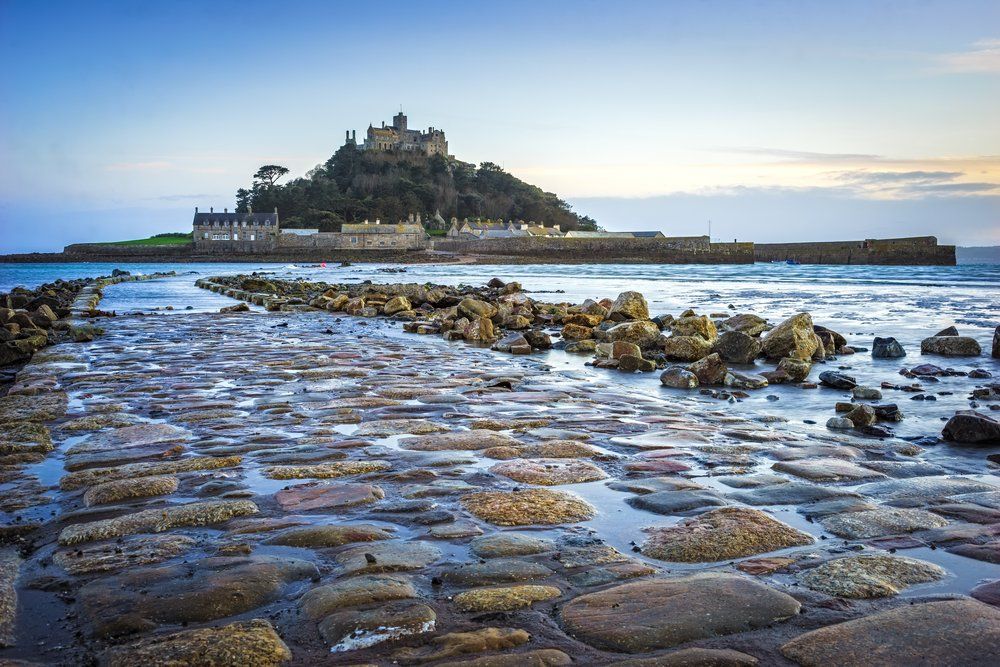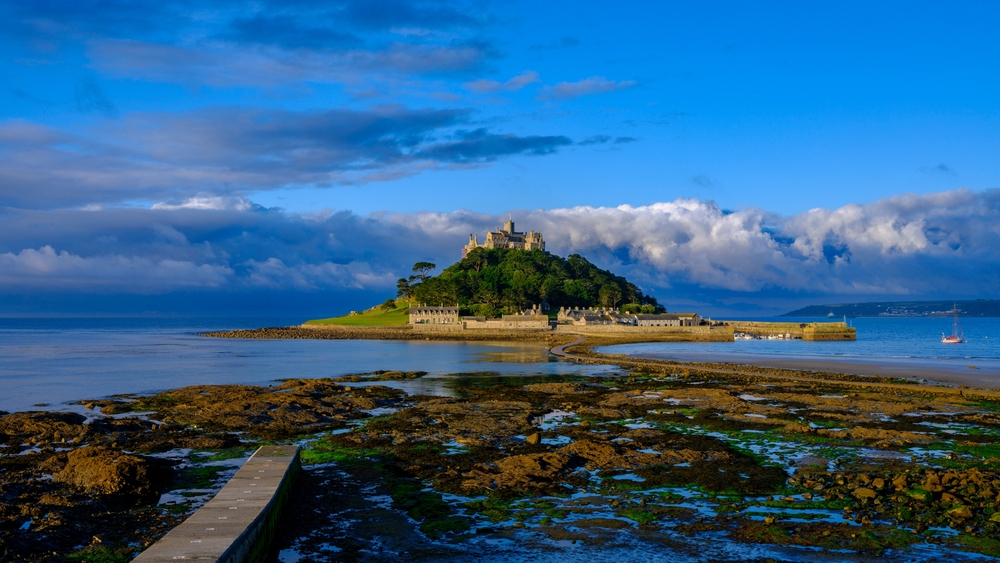Resting in the curved basin of Mount’s Bay is the fairy tale location of St Michael’s Mount. Myths and legends swirl around this island like sea mist and it has become a favourite destination for visitors to Cornwall to explore. But this place is very used to attracting visitors, beyond the tales of giants and civil war sieges, St Michael’s Mount has long been a place of pilgrimage.
Hundreds of years before the castle was built the Mount was known by a different name – ‘Carreck los yn cos” meaning ‘grey rock in the forest’ in Cornish. This name comes for a time in prehistory when the island was actually a rocky outcrop surrounded trees, before sea levels rose and it became cut off from the mainland. However, to this day at very low tides petrified trees from that era can still be seen poking up through the sand.
Adopting the name St Michael
The name ‘St Michael’ was adopted around 900 years ago, sometime after the first of the island’s miracles. It is said that in around 495AD the Archangel Michael appeared to some local fishermen while they were out in the bay in their boat. They looked up and saw a vision of the saint standing on a rocky ledge on the western side of the island, a place now known as St Michael’s Chair.
Soon after the first religious community settled on the Mount and in 1144 the first church was consecrated by the Bishop of Exeter and Benedictine Priory was established by Bernard of le Bec, Abbot of Mont St Michel in Normandy, the Cornish Mount’s twin.
This isolated island sanctuary in the far west of the British Isles soon began attracting a few Christian pilgrims. The faithful came to climb to the spot where the angel had stood, apparently this was a way to cleanse your soul of sin, and to pray in the chapel which was said to hold the jaw-bone of St Appolonia of Alexandria, a virgin martyr. But the number pilgrims increased dramatically after a series of miracles were recorded on the island in the 13th century.
A small library in Normandy in France holds a number of books from Mont St Michell. One book, a chronicle written by Abbot Robert of Torigni some 900 year ago, has three extra pages inserted that appear to have been written in 13th century.
The two religious communities of St Michael’s Mount and Mont St Michell had strong ties, and the monks would regularly visit between the two islands. It seems that on one occasion a brother from Cornwall transcribed some events that had been happening a home while he was in Normandy. He wrote about four miracles that had occurred on the Mount.
The miracles
The first miracle involved a woman called Christina who had come to Cornwall from Glastonbury in May 1262. The woman had been blind for six years but miraculously recovered her sight when she attended High Mass on the Mount.
The second miracle came about a month later when a young Cornish woman called Matilda recovered after lying unconscious for two days and having lost “the power of speech”. Her parents brought her to the Mount on 11th June 1262 and by the power of prayer she woke up and was able to speak again.
In January 1263 a young Welsh girl travelled to the Mount, apparently she had:
“for seven years past been deprived of the sight of her eyes, coming with the greatest devotion to the said church for the sake of prayer and pilgrimage on the 29th of January, before the rising of the sun, persevering in the greatest faith, by the prayers of the Blessed Archangel Michael recovered miraculously the sight of her closed eyes.”
The writer gives little detail for the fourth miracle, only recording that a male pilgrim had regained the power of speech after being dumb, but understandably it seems that St Michael’s Mount was getting a bit of a reputation!
For a while the journey to Marazion in Cornwall became one of the most important in the UK for Christian pilgrims. A route weaving its way across Cornwall between holy wells and ancient chapels became established, with hostels and eateries springing up to service the faithful as they made their way west.
In Mount’s Bay the monks leaned into their newfound fame as word of the miracles spread, because more pilgrims meant more offerings for their church. They built a chapel on the rock on the Marazion side, still known as Chapel Rock today, so that pilgrims could pray there first before making their way across to the island.
Part way across, whether the faithful were walking or taking a boat, they would also have passed a large granite cross that had been erected on the sand, a striking symbol swamped by the tide twice a day. This cross was swept away in a storm in the 18th century but the granite base is still visible today.

St Michael’s Mount pilgrimages
Pilgrimages to the Mount continued to be popular for hundreds of years, right into the early 16th century. It would seem that local people, as well as those who travelling to Cornwall, continued to believe in the power of this beautiful place.
It is likely that St Michael’s Mount would have kept a Register of Cures, a book in which the monks would have recorded all the miracles that had taken place there. Sadly it would appear that this book has been lost and all that now remains to recall those extraordinary events are the notes in Abbot Robert’s Chronicle recorded by a visiting brother who had made his way from Cornwall to Normandy in the 13th century.
